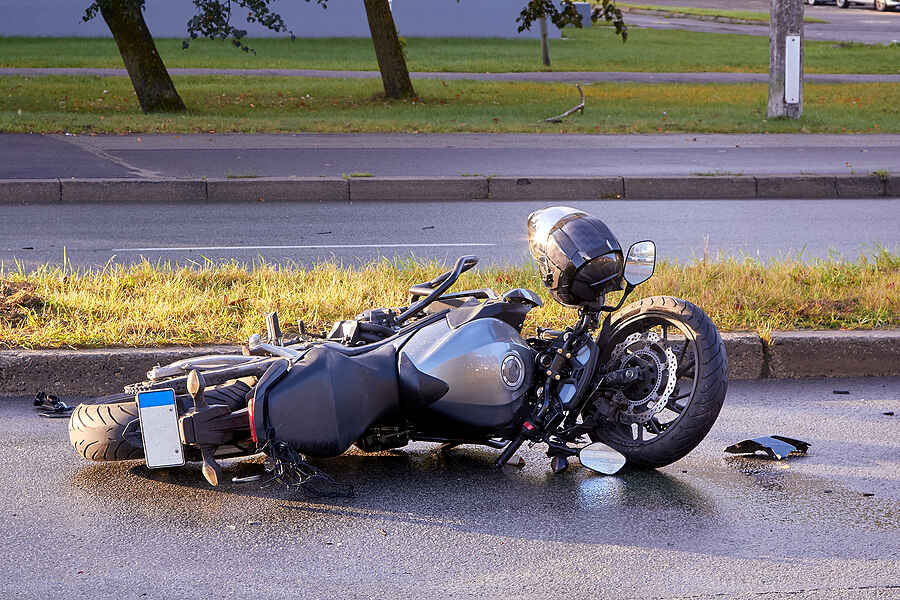Those injured in motorcycle accidents tend to suffer catastrophic injuries more often than those in car accidents. A motorcycle rider does not have the protection that a passenger vehicle offers—even small subcompact cars offer more protection. Even a motorcyclist that crashes without the negligence of another driver can suffer catastrophic injuries. Thus, it is a safe assumption that, pending fault, a motorcycle accident pays higher than many car accidents.
Causes of Motorcycle Accidents
Sometimes a motorcyclist causes the accident, and other times, someone else causes the wreck.
In either case, the causes are the same and include:
- Reckless and/or aggressive driving.
- Speeding, including excessive speeding.
- Driving while distracted.
- Driving under the influence of drugs or alcohol.
- Following too close.
- Manufacturers’ defects for a vehicle, the bike, or aftermarket parts on the bike or another vehicle.
- Poor vehicle and motorcycle maintenance.
- Weather conditions.
- Poorly maintained roads.
Preventing Motorcycle Accidents
A motorcyclist cannot prevent all accidents, but they can prevent many by minding the rules of the road. A motorcyclist can reduce the risk of catastrophic injuries by wearing the proper gear, including a helmet, long pants, hard shoes or boots, and long sleeves—preferably leather.
Many vehicle accidents happen because the person in the vehicle claims that they “didn’t see the motorcycle.” Always use your bike’s headlight—even during the day—to make it easier for other drivers to see you. And, always look at least 200 feet in front of you. Drivers tend to pull out of driveways and side roads without “seeing” a motorcycle.
Motorcyclists are constantly on the lookout for drivers who do not pay attention. Thus, the motorcyclist sometimes has more time to take evasive action to prevent a wreck.
However, sometimes, traffic and the area do not allow for evasive actions. In some cases, the accident is on top of you before you know it, especially if the vehicle comes from behind or your side.
Injury Prevention and Motorcycle Safety
A motorcyclist can prevent some injuries by knowing how to fall. And with the proper gear, you are less likely to suffer injuries such as road rash and traumatic brain injuries when combined with learning how to fall.
If possible, when you have to dump the bike—or when someone knocks it over as you are riding, try to land on top of the bike. The exhaust might burn through your clothes, but wearing a leather jacket will minimize this. When you land on top of the bike, it suffers road rash instead of you.
You also have less chance of having a 900-plus pound vehicle landing on top of you, which means less chance of broken bones, traumatic brain injuries, and other injuries.
If the road, weather, or another vehicle causes the bike to start wobbling, do not make any quick moves. Keep the wheel straight or, if you are trying to get off the road, at a slight angle. Do not hit the brakes unless you know you can control a skid.
Leave the bike in gear in case you need to give it a little gas to help control it. Otherwise, coast away from the danger. Never engage the clutch and coast in a dangerous situation. If you have to let the clutch out, it could grab and cause you to lose control. If you can downshift without clutching as you slow down, do that, but only if it will not distract you from keeping the bike upright.
Injuries a Motorcyclist Can Sustain
The injuries you might suffer in a motorcycle accident could range from minor bumps, bruises, scrapes, and cuts, to death, and include:
- Road rash.
- Strains and sprains.
- Pulled and torn muscles and other soft tissue injuries.
- Simple and compound fractures.
- Crushed bones.
- Crush injuries.
- Face and eye injuries.
- Internal injuries.
- Chemical and thermal burns.
- Traumatic brain injuries.
- Head, neck, and shoulder injuries.
- Back and spinal cord injuries.
After a bike accident, do not move if you believe moving will cause additional injuries. Try to get to a safe place away from traffic if possible.
If you can move without causing additional damage, call first responders and take photos of the accident. Allow emergency technicians to check you over and give the police officer your version of the events. You should also obtain contact, registration, and insurance information from the other driver, and contact information from witnesses.
After the police release you from the scene, seek medical attention immediately. Allowing the EMTs to check you at the accident scene starts the injury documentation that you need to recover damages.
Recovering Damages After a Motorcycle Wreck
After a motorcycle accident, you can recover compensatory damages. In some cases, if you can prove the other driver’s actions or inactions were grossly negligent or intentional, you might recover punitive damages.
Compensatory damages include economic and non-economic damages. The court orders a defendant to pay compensatory damages to make you whole again.
Economic damages could include medical expenses, replacement or repair of destroyed or damaged personal property, lost wages, loss of future earning income, and funeral and burial expenses if you lost a loved one in the accident.
Non-economic damages include pain and suffering, loss of quality of life, loss of consortium and/or companionship, loss of use of a body part or bodily function, amputation, disfigurement, and excessive scarring.
No attorney can guess what you might recover since all accident injuries affect people differently. However, an attorney can tell you what they recovered in cases similar to yours. Accident injuries that cause long-term or permanent disabilities will pay more than an accident that caused injuries that doctors expect to heal within a few weeks or months.
Contact a motorcycle accident attorney for a free case evaluation if you suffered injuries or lost a loved one in a motorcycle accident.


